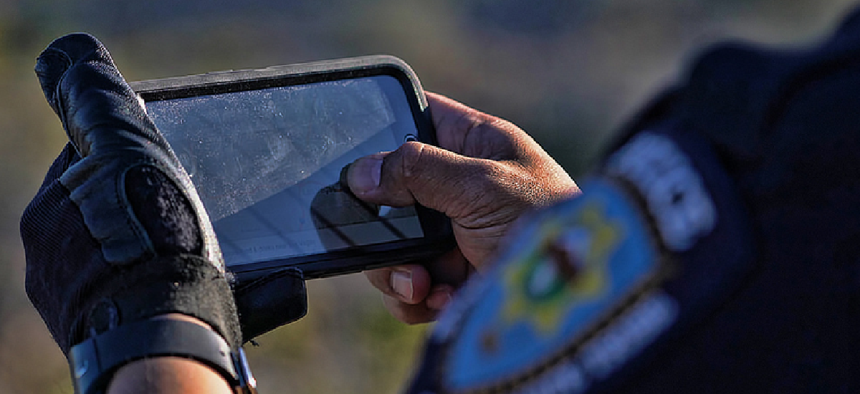FirstNet apps: How first response gets done

The FirstNet app catalog features applications that have been vetted for their relevancy, security and resiliency.
FirstNet’s first job is to provide responders with a dedicated broadband network that gives them priority and preemption options during emergencies. But since its launch in 2017, the FirstNet App Catalog has emerged as a crucial element of the ecosystem.
“The real power of a smartphone or a tablet computer comes not in access to the network -- that’s kind of a given -- but it comes in the applications, the apps that are on the device that actually make public-safety agencies more efficient and more effective, protect the public and protect the responder,” said Bill Schrier, senior adviser at the FirstNet Authority, the government entity Congress authorized in 2012 to develop, build and operate the nationwide network. “The apps are the core, I think, of FirstNet in terms of what a boots-on-the-ground police officer or firefighter sees and helps them to do their job.”
Apps go through a rigorous review process to determine their relevancy, security and resiliency before becoming part of the catalog. The security piece is often the toughest to pass on the first try, Schrier said.
There are two categories of apps in the catalog: listed and certified. For the first, vendors use security-scanning software provided for free by AT&T, the company charged with managing the network. It runs against the binary, or executable code, and checks for issues.
To be certified, however, app developers must buy one of two approved security scanners that check the app’s source code.
The investment is worth it, Schrier said. “If a company really wants this designation -- which is pretty valuable for their particular app because it tells 60,000 agencies across the United States that there’s been some rigorous looking at their app -- if they want that prestigious designation, they need to go through the work.”
To facilitate the ability of large companies and startups alike to get apps into the catalog, there is no listing fee, Scott Agnew, assistant vice president of product marketing at AT&T, said in an email to GCN.
“This levels the playing field for all sizes of app providers,” he said.
About 200 apps have been submitted to be part of the catalog, and 93 are currently listed, although that total counts both iOS and Android versions of apps. The number of unique apps is a little more than half that figure, Schrier said.
The catalog gets 8,000 to 9,000 visits per month, and being listed carries weight.
“I’m amazed by how much interest there is,” Schrier said. “When I talk to public-safety agencies and I talk to chief information officers or assistant police chiefs or fire chiefs, they’re starting to now pitch their vendors: ‘Have you got a FirstNet certification?’ ‘Are you listed in the FirstNet catalog? If not, why not?’ he said. "We’re starting to see actual public-safety agencies encourage their vendors and use this [designation] as one of the criteria that they’re using when making decisions about what apps to use.”
Apps currently in the catalog include those that address workflow management, field collaboration, video and body-worn camera capabilities as well as ones that feature federal information resources for state, local and tribal agencies. Here’s a look at some of the most notable.
- AccessMyLAN for FirstNet -- A FirstNet-exclusive app that provides on-demand access to manage network connections and device access. The Wagoner County, Okla., Sheriff’s Office uses this app to secure mobile communications from in-patrol car routers, laptop computers and responders’ smartphones.
- CrisisGo -- A digital safety and crisis response platform that helps responders prepare for and respond to emergencies. Earlier this year, CrisisGo partnered with Sonim Technologies to integrate the app into Sonim’s XP8 ultra-rugged device to help keep school personnel connected during crises.
- Fleet Complete Mobile -- GPS fleet, asset and worker tracking and data sharing on the go. Agencies can remotely track vehicles, run engine diagnostics, get crash notifications and check sensors that monitor maintenance needs and fuel consumption.
- FirstNet Assist -- Allows public-safety support personnel in the field to see active events and incidents within a 50-mile radius and request device uplift to receive a higher quality of service when networks are congested. It also gives all users direct access to FirstNet care specialists specially trained to help first responders and perform device diagnostics.
- GD E-Bridge -- An app enabling live communications between and among emergency medical services and hospital teams through the sharing of protocol workflows, information and multimedia.
- Response for FirstNet -- A FirstNet-exclusive situational awareness collaboration platform that gives FirstNet subscribers features such as live location, media sharing and team mobilization status data.
- Visual Labs Smartphone Body Worn Camera -- Body digital camera and audio recorder, plus livestreaming and location analytics from a smartphone. The Kit Carson County Sheriff’s Office in Burlington, Colo., uses this to livestream from the field, giving central command real-time access to the content.
FirstNet-related smartphones became available Aug. 23: the FirstNet Ready Samsung Galaxy Note10 and Galaxy Note10+ devices are now approved to operate on the network. Additionally, FirstNet users may soon get access to high-power user equipment on 700 MHz Band 14 spectrum, which could significantly extend a cell site’s effective range.
NEXT STORY: Latest FedRAMP authorizations





